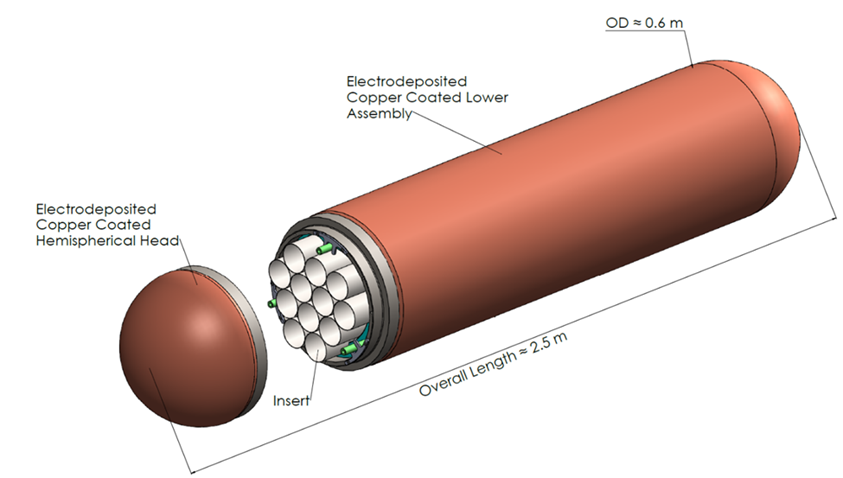The Copper Coated Used Fuel Container is the main containment barrier in the engineered barrier system. The role of copper coated used fuel container is to provide containment for used CANDU (CANada Deuterium Uranium) fuel and any other fuel deemed acceptable for a deep geological repository in accordance with the Nuclear Fuel Waste Act (S.C. 2002, c.23) and Nuclear Waste Management Organization’s waste acceptance criteria.
- copper
- used fuel container
- lifetime prediction
The primary safety function of copper coated used fuel container (UFC) is to confine the radioactive material over a time frame in the order of 1 million years. This safety function would be fulfilled by: 1) Maintaining the UFC configuration and integrity against internal and external loads; and 2) Controlling the corrosion rate of the UFC materials so that containment can be maintained within the time frame of interest. The UFC configuration and integrity will be maintained by a structural vessel designed to withstand loads. The corrosion rate will be controlled by directly applying copper coating as a corrosion barrier outside the structural vessel. The current reference UFC design, as shown in Figure 1, includes a steel structural vessel made of mild carbon steel and a corrosion-resistant copper coating bonded to the exterior of the steel vessel. An internal steel structure referred as the Insert is designed to hold 48 used CANDU fuel bundles (i.e., configured in 4 layers with 12 bundles per layer). The UFC has an overall length of about 2.5 meters and a diameter of about 0.6 meter. The weight of a UFC loaded with used fuel bundles is about 3 metric tonnes.

Figure 1: The schematic of NWMO copper coated used fuel container design for the disposal of used CANDU fuel
The selection of the 48-bundle vessel is based on the results of the used fuel container sizing study which identified this design as an optimal mid-sized container in terms of vessel manufacturability and operation. This design permits the use of readily available standard materials to fabricate the structural vessel instead of a custom forged product. The size and weight of the container are manageable using commercially available equipment, and also better facilitate automated operations for fuel packaging, buffer assembly, handling and placement. The reference UFC incorporate two hemi-spherical heads coupled with a standard steel pipe through welding. The hemi-spherical heads are designed for optimal stress distribution under external pressure. The weld is designed to provide sufficient strength while reducing the welding and inspection operations in the radioactive (hot cell) environment. The fully bonded copper coating is designed to achieve enhanced corrosion barrier strength and saving of material.
Using data from high purity wrought copper as a reference [1][2], the NWMO estimates that copper corrosion processes will penetrate less than 0.27 mm into copper over 1 million years under normal conditions and under pessimistic scenarios, 1.2 mm [3][4]. NWMO’s UFC design includes a copper coating that is 3 mm thick, and this is based on a corrosion allowance and a safety margin.
Copper coatings differ from wrought copper in two ways: a) purity, and b) metallurgical structure. This difference is due to the manufacturing process. Extensive research has been conducted for the previous Canadian reference container [1][2], and for Swedish and Finnish containers which utilize a thick wrought copper overpack as the corrosion barrier in a dual-vessel design. It is noteworthy that the oxygen-free phosphorus-containing copper (Cu OFP) used in the fabrication of the overpack in these containers has been selected for both mechanical and corrosion performance reasons, as these free-standing parts must handle large hydrostatic loads within the repository and must not fail by processes such as creep fracture or cracking. In the current NWMO container design, copper coatings have much lower mechanical requirements, as structural support is provided by underlying steel. The main mechanical requirements for copper coatings are ductility and adhesion strength. As a result, there is a significantly reduced requirement to consider mechanical properties of the copper as a separate part.
This entry is adapted from the peer-reviewed paper 10.3390/cmd2040037
References
- Used Fuel Repository Conceptual Design and Postclosure Safety Assessment in Crystalline Rock. Nuclear Waste Management Organization Report Pre-project Report
- Postclosure Safety Assessment of a Used Fuel Repository in Sedimentary Rock. Nuclear Waste Management Organization Report Pre-project Report NWMO TR-2013-07.
- David S. Hall; Mehran Behazin; W. Jeffrey Binns; Peter G. Keech; An evaluation of corrosion processes affecting copper-coated nuclear waste containers in a deep geological repository. Progress in Materials Science 2020, 118, 100766, 10.1016/j.pmatsci.2020.100766.
- Peter G. Keech; Mehran Behazin; W. Jeffrey Binns; Scott Briggs; An update on the copper corrosion program for the long‐term management of used nuclear fuel in Canada. Materials and Corrosion 2020, 72, 25-31, 10.1002/maco.202011763.
